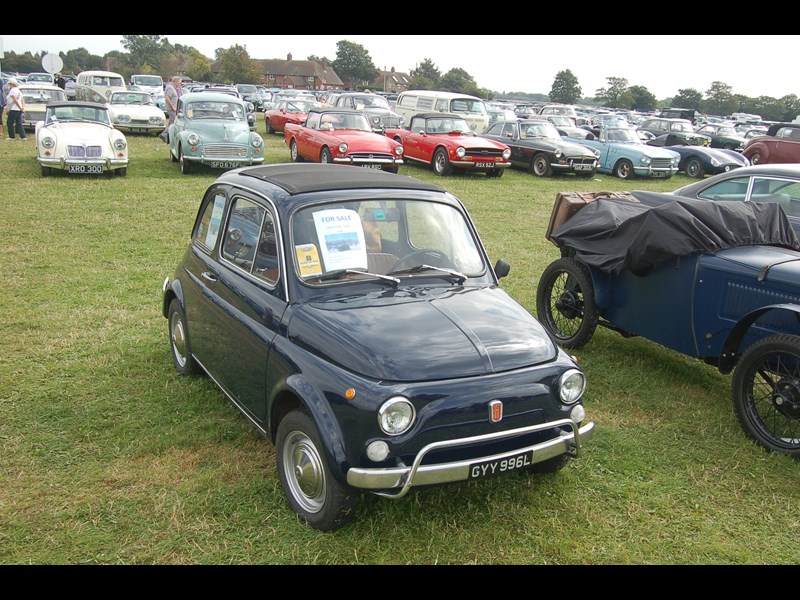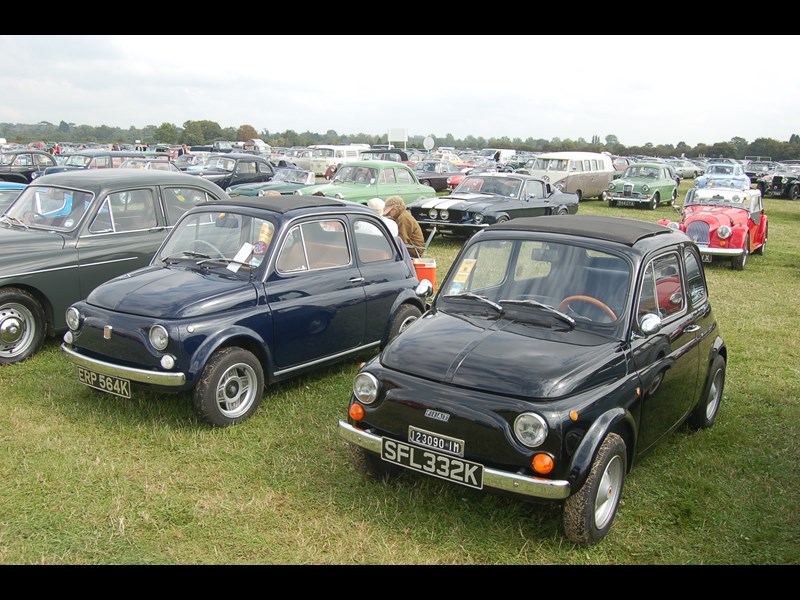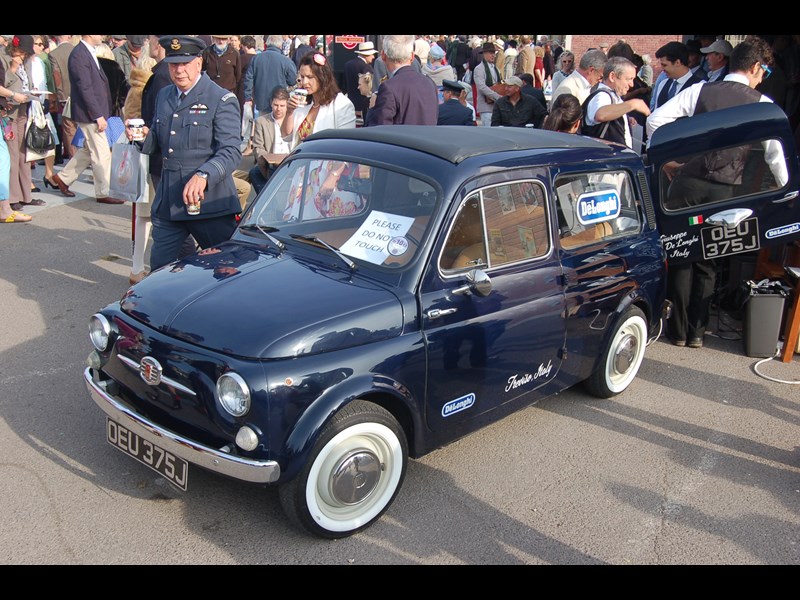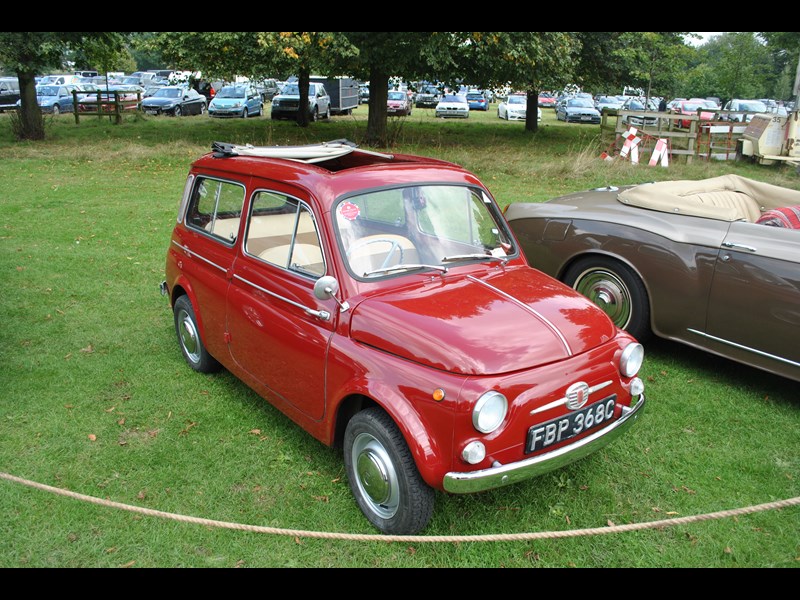
Fiat 500 Classic Car Review
The replacement for FIAT's much-loved 500 Topolino, the Nuova 500 debuted in 1957. A radical departure from its predecessors essentially pre-war design, FIAT's new baby featured unitary construction, an opening fabric roof and all-independent suspension while carrying its engine at the rear. The latter was an air-cooled, overhead-valve twin – the first such used by FIAT – and the gearbox was a four-speeder. Introduced in 1968 alongside the standard 500F, the deluxe Fiat 500L, while mechanically identical, came with exterior cosmetic enhancements and an improved interior featuring new instrument panel, seats and floor covering. An immense success for FIAT, almost 3,000,000 of these adorable little cars had been sold when production ceased in 1975. The 500 remains as popular today as it ever was.
Approach a classic 500 for the first time and you can't fail to be struck by just how small it is, with every part seemingly made in half scale. So does it feel just as compact on the inside? Well, yes and no.
You're certainly not going to find plenty of lounging room – it would be somewhat strange to expect otherwise – but despite the titchy external dimensions you rarely feel cramped behind the wheel, and as with the Mini extra passengers can be squeezed in without too much discomfort. Sliding back the sunroof provides an even airier feel.
What you’ll also notice straightaway is the pared-back nature of the cabin. There are motorcycles with more instrumentation and switches than this, but it doesn’t detract from the enjoyment in the slightest. Instead you can just revel in the delightful simplicity of the whole thing, free of the complication and fripperies that adorn many a modern car’s interior. Even the small, flat seats are more comfortable than they look over longer distances.
And the driving experience? Well it benefits from the same simplicity and sense of fun as the rest of the car, the tiny air-cooled twin threshing away behind you as you pin throttle to floor to extract the last ounce of performance. Yes the stopwatch tells you this is a very slow car, taking over half a minute to hit 50mph, but it doesn’t feel that way from behind the steering wheel as you’re simply too busy grinning at the sheer fun of the thing. The only fly in the ointment is the non-synchromesh gearbox, so it pays to have brushed up on your double-declutching skills, but the gearchange itself is accurate enough to allow you to make the most of the power available. The rest of the controls require no special allowances though; the steering is light and direct, adding to the sense of agility, while the drum brakes are powerful enough as long as they are in good condition. Ride and handling are pretty adept too, adding to the 500’s fun, chuckable appeal.
VITAL STATISTICS
Engine 499cc/2-cyl/OHV
Power 21.5bhp@4600rpm
Torque 22lb ft@3000rpm
Top speed 65mph
0-60mph 33sec
Economy 45mpg
Gearbox 4-speed manual
WHAT TO LOOK FOR
BODYWORK & CHASSIS
The 500 rusts with the best of them so you’ll need to check every panel and seam. All of the usual spots need examining - sills, wheelarches, door bottoms - but pay particular attention to the front panel behind the headlamps; the rear engine lid; and around the front and rear screens. Inner and outer wings can disintegrate, and make sure you check the front luggage compartment focusing on the battery tray and the area beneath the spare wheel. Sourcing panels for the very earliest models and estate can be tricky too.
Rot in the floorpan can be a major issue on neglected cars - leaking fabric sunroofs won’t have helped here either, but they are cheap to replace - so make sure you lift the carpets and get the car on a ramp to be certain of condition. While underneath, check the state of the suspension mounting points, especially the rear springs, and make sure that crash damage hasn’t knocked the engine and gearbox out of kilter. And look for poor panel fit and filler-laden bodywork - high restoration costs means bodgery is rife.
ENGINE
The engines are tough little units but it pays to check for signs of neglect. Expect a few oil leaks - usually from sump and rocker cover gaskets - but these shouldn’t be too serious while excessive exhaust smoke points to an imminent rebuild. Correct operation of the engine cooling flaps is vital and erratic running or stalling can signify a unit with overheating problems - if left it will destroy the head gaskets, or worse the aluminium heads themselves. Check to see the flaps haven’t been wedged open to mask a problem. Worn timing chains aren’t uncommon while starting problems are often caused by a worn carburettor or distributor - failed ignition condensers can be a particular bugbear. The little twin benefits from regular plug changes too, using good-quality items. Giardiniera engines are laid on their side and cooling arrangements differ slightly, but otherwise the same caveats apply.
It’s also worth ensuring the engine is the correct one for the year as swaps are fairly common, including a change to the slightly more powerful unit from the Fiat 126. It's fine if done properly but it might upset the purists out there. The non-synchromesh gearbox is generally robust, but if it’s excessively noisy or jumps out gear budget for replacement, or a professional rebuild as it’s not an especially easy DIY task.
SUSPENSION
The suspension is a straightforward set-up, but it can suffer from a few issues. Aside from rusty mounting points you also need to check for corrosion or cracks in the rear semi-trailing arms, and for corrosion in the transverse front leaf spring. If the latter appears to be bulging in places, chances are it's rotten and at risk of breakage (regular lubrication can prevent the problem). Ask the owner or vendor about the greasing regime too as the front kingpins need lubricating every 1000-1500 miles and they’ll seize and fail if this is ignored.
STEERING
Vague steering or uneven tyre wear points to wear in the worm and sector steering box and/or idler arm, and if the steering feels stiff it’s likely to have been over-adjusted to cure play. Refurbishment is neither especially difficult nor expensive. The drum brakes are fine with regular maintenance, so if they feel spongy or particularly ineffective it’s likely that leaking wheel cylinders or seized adjusters are to blame. An overhaul is simple and cheap but they need proper setting-up.
INTERIOR
The interior is simplicity itself, so wear and tear will be immediately apparent. A re-trim is fairly straightforward then, but bear in mind that some early trim parts and dashboard components may be hard to source so finding one that’s complete and in working order is best. And on imports it’s also worth checking that any right-hand drive conversions have been done properly – get a specialist inspection if you’re not sure.
OUR VERDICT
If it’s performance you’re after you’ll need to look elsewhere, but if owning a fun and quirky classic floats your boat the 500 is almost irresistible. It’s not without problems though so you’ll need to buy carefully but a car as charming and characterful as this one will provide a unique ownership experience. It’s an appealing and very tempting proposition.



